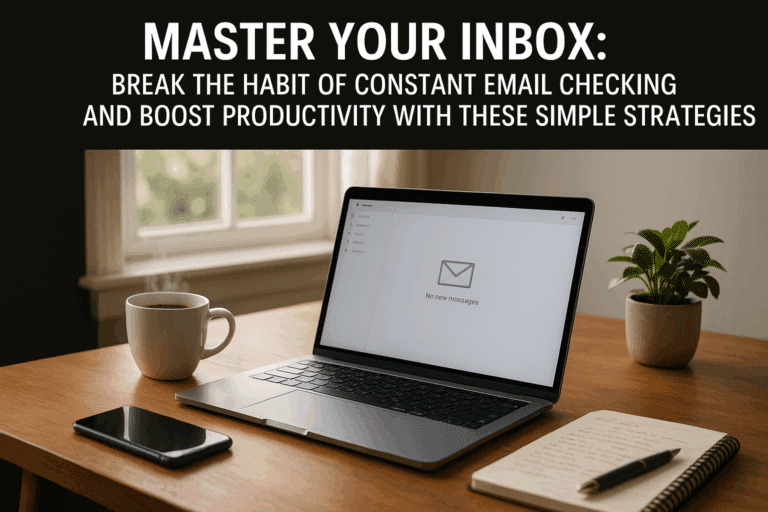We’ve all been there—sitting in front of a computer screen or holding a set of tools, trying to summon the energy to keep going. Yet, despite the mugs of coffee and the sheer willpower, productivity plummets, and fatigue sets in. What if I told you that the key to sustaining momentum isn’t about pushing through, but about taking strategic rest? Yes, you read that right! Mastering the art of productive breaks might just be the fuel you need to supercharge your productivity. 🚀
In the marathon of professional life, many perceive breaks as a sign of weakness—a divergence from the path of success. But contrary to popular belief, embracing rest is not an obstacle but an ally. It’s a common misconception that the road to success is paved solely with continuous work, but science says otherwise. So, before you reach for another energy drink, buckle up as we embark on a journey to re-define productivity and uncover the power of strategic rest. 💡
Understanding the Science Behind Productive Breaks
Our brains are not designed for extended periods of intense concentration. Just as your muscles need recovery time after a strenuous workout, your brain needs time to recharge after intense cognitive activities. 🧠 Studies have shown that taking short breaks can dramatically increase focus, creativity, and ultimately, productivity. Productive breaks are not a luxury; they are a necessity.
What’s in the Agenda?
In this comprehensive guide, we will delve into the heart of why and how breaks can turbocharge your productivity. We will debunk common misconceptions and provide you with practical strategies to implement productive breaks in your daily routines, whether you’re an entrepreneur, an engineer, a writer, or simply someone aiming to get more out of their day. 💼🔧📝
Understanding Your Rhythm: The Ultradian and Circadian Rhythms
Did you know that your body operates on internal clocks that significantly influence your energy levels and cognitive performance? We will examine how understanding these natural rhythms—the Ultradian and Circadian Rhythms—can guide you to schedule your productive breaks optimally, syncing your rest periods with your body’s natural ebb and flow of energy. ⏰
Strategies for Effective Breaks
Not all breaks are created equal. A well-planned rest can be a powerful tool for rejuvenation, while an ill-timed or poorly structured break can leave you feeling even more drained. We will explore a range of evidence-based strategies—from short ‘micro-breaks’ to longer ‘recovery breaks’—that you can use to design your personalized, productivity-boosting break routine. 🎯
Re-defining Productivity
Ultimately, this guide aims to challenge and expand your understanding of productivity. It’s not about how long you work, but how smart you work. And a significant part of working smart is knowing when to pause, reflect, and recharge. It’s time to let go of the ‘hustle culture’ that glorifies burnout and embrace a more sustainable, balanced approach to work—and life. 🌱
So, whether you’re struggling with work-induced fatigue or simply curious about optimizing your performance, you’re in the right place. Dive in, and let’s start redefining productivity together! 🌊
The Intricacies of Productive Breaks: A Deep Dive
Understanding the power of a well-placed break can make a significant impact on productivity levels. The human brain wasn’t designed to focus intently on tasks for prolonged periods; breaks allow us to reset our focus, reduce stress, and refresh our motivation. This article explores the art of mastering productive breaks, using them to fuel momentum, and the benefits of strategic rest.
There’s an art to taking breaks that many people may overlook. The reality is, breaks aren’t just about time away from work; they’re about resetting, refreshing and refueling. This article provides a deep dive into the topic, exploring the science behind breaks, the different types of breaks, and how to take a productive break.
The concept of “productive breaks” might seem counterintuitive. After all, isn’t the point of a break to be… well, a break? But as we’ll see, the science suggests that the right kind of rest can actually fuel productivity, rather than hindering it. Let’s explore further.
The Science Behind Breaks
Human brains have a natural rhythm of work and rest, known as the Ultradian Rhythm. We can focus and work effectively for about 90-120 minutes, after which our brain needs a break. Ignoring these natural signals and forcing the brain to continue working can lead to mental fatigue, decreased productivity, and stress.
In contrast, taking regular breaks – especially ones that involve movement or relaxation – can help to reset the brain, improve focus and creativity, and reduce stress. These benefits aren’t just theoretical; numerous scientific studies have confirmed them.
For a deeper understanding of the science behind breaks, watch this enlightening video titled “The Science of Productivity” by AsapSCIENCE on YouTube.
Types of Breaks
Not all breaks are created equal. The type of break you take can significantly affect its productivity benefits. Below are three common types of breaks, each with its unique benefits:
- Microbreaks: These are short, 5-10 minute breaks taken every hour or so. They can involve stretching, taking a quick walk, or simply resting your eyes. Microbreaks are great for maintaining a steady level of productivity throughout the day.
- Regular breaks: These are longer, 15-30 minute breaks taken every few hours. They can involve taking a walk, meditating, or eating a snack. Regular breaks are perfect for resetting and recharging.
- Extended breaks: These are breaks of an hour or more, typically taken in the middle of the day (like a lunch break). Extended breaks can involve eating a meal, exercising, or even taking a nap. These breaks are essential for deep recovery and rejuvenation.
How to Take a Productive Break
Taking a productive break is more than just stopping work. It’s about strategically choosing activities that rejuvenate your mind and body. Here are a few tips to maximize the productivity benefits of your breaks:
- Choose restful activities: Choose activities that help you relax and de-stress. This could be a quick walk, meditation, or even a power nap. Avoid activities that require intense mental effort, like checking emails or scrolling through social media.
- Plan your breaks: Instead of waiting until you feel exhausted, plan your breaks ahead of time. This helps to maintain a steady rhythm of work and rest, preventing burnout.
- Move your body: Physical activity helps to relieve tension and boost mood. Even a quick stretch or a walk around the block can do wonders for your productivity.
Productive Breaks: A Comparative Overview
Not every break is beneficial. The table below provides a comparative overview of productive versus unproductive breaks, offering insights into what makes a break truly beneficial.
| Productive Breaks | Unproductive Breaks |
|---|---|
| Involve restful activities (walking, stretching, meditating) | Involve high-effort activities (checking emails, working through lunch) |
| Planned ahead of time | Taken only when feeling exhausted |
| Involve physical movement | Sedentary (sitting, screen time) |
Mastering the art of productive breaks isn’t just about taking time off work. It’s about using that time effectively to refresh, reset and refuel. By understanding the science behind breaks, recognizing the different types of breaks, and learning how to take a productive break, you can use your rest time strategically to fuel your productivity and momentum.
Don’t just take my word for it – try it for yourself. Plan your breaks strategically, choose restful activities, and see how it impacts your productivity. You might be surprised at the results.

Conclusion
In Conclusion
In the course of this comprehensive article, we have taken an in-depth journey into the realm of software engineering, its principles, importance, and impact on modern technology. If there’s one thing we must take away from this discourse, it’s the undeniable fact that software engineering is a pillar that supports the continuous evolution of technology. 🌐💻
Recap
We began by exploring the basic definition of software engineering and understanding its function in creating reliable and efficient software solutions. We examined the crucial role of a software engineer and the vast array of skills that one must possess, including a solid foundation in coding, a knack for problem-solving, an understanding of software development life cycle (SDLC) methodologies, and an ability to work well in a team. 🧠👨💻🚀
We then delved into the principles of software engineering, focusing on key factors such as modularity, abstraction, and encapsulation. Each of these principles, as we have seen, is instrumental in ensuring that the software developed is of high quality, maintainable, and meets the client’s requirements effectively. 🏗️📚
The Road Ahead
Our exploration did not stop at merely understanding the principles and roles within software engineering. We also examined its profound significance in the current era. With almost every industry relying on technology to perform their operations efficiently, the demand for software engineers is at an all-time high.💼📈
However, the road ahead is not without challenges. From coping with rapid technological changes to dealing with complex project requirements, software engineers must constantly evolve and adapt to stay relevant.
It is our hope that this article has provided you with a deeper insight into the world of software engineering, whether you’re a seasoned professional, an aspiring engineer, or simply a curious reader. 👨🎓👩🎓
Be Part of the Conversation
Do you have thoughts on this topic, questions, or experiences to share? We encourage you to leave a comment below. Remember, your insights could be the spark that inspires others to delve deeper into this fascinating subject. 💬👥
We also invite you to share this article within your network. As we strive to demystify complex topics and make technical knowledge more accessible, your shares can go a long way in achieving this goal. 🔄💡
Lastly, for those who wish to delve deeper into this subject, we recommend checking out the resources linked within this article, as well as IEEE’s guide on software engineering.
Remember, knowledge is power and sharing it only makes us stronger. Keep learning, keep growing, and keep pushing the boundaries of what is possible with technology. The future is yours to shape. 🚀🌟
References
Association for Computing Machinery (ACM)
International Journal of Engineering Research & Technology (IJERT)
IEEE guide on software engineering
Tags: #SoftwareEngineering #Technology #Coding #SDLC #FutureTech
Disclaimer: All links provided in this article were active and relevant at the time of publication.



